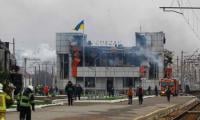DUGWAY, United States: A seven-year space voyage came to its climactic end on Sunday when a Nasa capsule landed in the desert in the US state of Utah, carrying to Earth the largest asteroid samples ever collected.
Scientists have high hopes for the sample, saying it will provide a better understanding of the formation of our solar system and how Earth became habitable.
“Touchdown of the Osiris-Rex sample return capsule!” a commentator said on Nasa’s live video webcast of the landing, as engineers and team members applauded at a nearby mission control centre.
Completing a 3.86-billion-mile journey, it marked the United States´ first sample return mission of its kind, the US space agency said in a post on X, the former Twitter.
Nasa chief Bill Nelson hailed the mission and said the asteroid dust “will give scientists an extraordinary glimpse into the beginnings of our solar system.”
The Osiris-Rex probe’s final, fiery descent through Earth’s atmosphere was perilous, but Nasa managed to engineer a soft landing at 8:52 am local time (1452 GMT), in the military’s Utah Test and Training Range.
Four years after its 2016 launch, the probe had landed on the asteroid Bennu and collected what Nasa estimated is roughly nine ounces of dust from its rocky surface.
Even that small amount, Nasa says, should “help us better understand the types of asteroids that could threaten Earth.”
The sample return “is really historic,” Nasa scientist Amy Simon told AFP. “This is going to be the biggest sample we´ve brought back since the Apollo moon rocks” were returned to Earth.
Osiris-Rex released its capsule early on Sunday from an altitude of more than 67,000 miles.
The fiery passage through the atmosphere came only in the last 13 minutes, as the capsule hurtled downward at a speed of more than 27,000 miles per hour, with temperatures of up to 5,000 Fahrenheit.
Its rapid descent was supposed to be slowed by two successive parachutes as it made its way to the 37-mile by nine-mile landing zone.
The main chute, however, deployed “much higher than was originally anticipated,” at about 20,000 feet (6,100 meters) rather than 5,000 feet, Nasa said.
Nasa images showed the tire-sized capsule on the ground in a desert wash, with scientists approaching the device and taking readings.
Eventually they concluded the capsule was not breached, meaning its all-important air-tight seal remained intact, avoiding any contamination of the sample with desert sands. The team then lifted the capsule by helicopter to a nearby “clean room.”
Meanwhile, the probe that made the space journey fired its engines and shifted course away from Earth, Nasa said, “on its way” for a date with another asteroid, known as Apophis.Scientists predict that asteroid will come within 20,000 miles of Earth in 2029.















